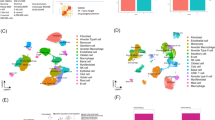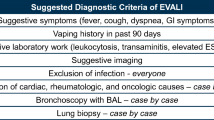Abstract
Electronic cigarette (e-cigarette) use has been linked to recent acute lung injury case clusters in over 2000 patients and dozens of deaths in the United States, however, the mechanism leading to lung injury is not certain although ultrafine particles, heavy metals, volatile organic compounds, and other harmful ingredients have been implicated. To systematically evaluate e-cigarette toxicity, we generated e-cigarette aerosols by varying the puff numbers (20–480), nicotine contents (0–24 mg/mL), and collected e-cigarette samples through an im**er system for biological assays. The calculated samples’ concentration ranged from 1.96 to 47.06 mg/mL. THP-1 monocyte-differentiated macrophages, BEAS-2B bronchial epithelial cells, wild-type C57BL/6 mice, and NF-κB-luc transgenic mice were used to test the effects of these samples. E-cigarette samples showed cytotoxicity to THP-1 cells and BEAS-2B in vitro, leading to increased oxidative stress, inflammatory cytokine production with or without nicotine, and cell death. Furthermore, aerosol generated from PG is more toxic than VG. The toxicity of e-cigarette samples is at least partially due to the reactive oxygen species and aldehydes, which are generated during the aerosolization processes by the e-cigarette device. After NF-κB-luc mice exposed with e-cigarette samples by oropharyngeal aspiration, NF-κB expressions were observed in a dose–response fashion with or without nicotine. In addition, the e-cigarette samples induced neutrophil infiltration, IL-1β production, oxidative stress marker heme oxygenase-1 expression in wild-type C57BL/6 mice. These results suggested that oxidative stress, pro-inflammatory NF-κB pathway activation, and cell death are involved in e-cigarette aerosol-induced acute lung inflammation.






Similar content being viewed by others
References
Adroit Market Research (2018) Global E-cigarette market size 2017 by type (disposable, rechargeable, modular), by region and forecast 2018 to 2025. https://www.adroitmarketresearch.com/industry-reports/e-cigarette-market. Accessed 10 Sep 2019
American Lung Association (2016) E-cigarettes and Lung Health. American Lung Association. https://www.lung.org/stop-smoking/smoking-facts/e-cigarettes-and-lung-health.html. Accessed 30 Aug 2017
Behar RZ, Hua M, Talbot P (2015) Puffing topography and nicotine intake of electronic cigarette users. PLoS ONE 10:e0117222. https://doi.org/10.1371/journal.pone.0117222
Blount BC et al (2019) Vitamin E acetate in bronchoalveolar-lavage fluid associated with EVALI. N Engl J Med 382:697–705. https://doi.org/10.1056/NEJMoa1916433
Bolt HM (2020) Electronic cigarettes and va**: toxicological awareness is increasing. Arch Toxicol 94:1783–1785. https://doi.org/10.1007/s00204-020-02786-3
Davidson K et al (2019) (2019) Outbreak of electronic-cigarette-associated acute lipoid pneumonia—North Carolina, July–August. MMWR Morb Mortal Wkly Rep 68:784–786. https://doi.org/10.15585/mmwr.mm6836e1
Farsalinos KE, Romagna G, Tsiapras D, Kyrzopoulos S, Voudris V (2013) Evaluation of electronic cigarette use (va**) topography and estimation of liquid consumption: implications for research protocol standards definition and for public health authorities’ regulation. Int J Environ Res Public Health 10:2500–2514. https://doi.org/10.3390/ijerph10062500
Farsalinos KE, Voudris V, Poulas K (2015) E-cigarettes generate high levels of aldehydes only in “dry puff’ conditions. Addiction 110:1352–1356. https://doi.org/10.1111/add.12942
Feldman R, Meiman J, Stanton M, Gummin DD (2020) Culprit or correlate? An application of the Bradford Hill criteria to Vitamin E acetate. Arch Toxicol 94:2249–2254. https://doi.org/10.1007/s00204-020-02770-x
Flora JW et al (2016) Characterization of potential impurities and degradation products in electronic cigarette formulations and aerosols. Regul Toxicol Pharmacol 74:1–11. https://doi.org/10.1016/j.yrtph.2015.11.009
Flouris AD et al (2013) Acute impact of active and passive electronic cigarette smoking on serum cotinine and lung function. Inhal Toxicol 25:91–101. https://doi.org/10.3109/08958378.2012.758197
Fuoco FC, Buonanno G, Stabile L, Vigo P (2014) Influential parameters on particle concentration and size distribution in the mainstream of e-cigarettes. Environ Pollut 184:523–529. https://doi.org/10.1016/j.envpol.2013.10.010
Guan ZZ, Yu WF, Nordberg A (2003) Dual effects of nicotine on oxidative stress and neuroprotection in PC12 cells. Neurochem Int 43:243–249. https://doi.org/10.1016/S0197-0186(03)00009-3
Hedstrom AK, Hillert J, Olsson T, Alfredsson L (2013) Nicotine might have a protective effect in the etiology of multiple sclerosis. Mult Scler 19:1009–1013. https://doi.org/10.1177/1352458512471879
Henry TS, Kanne JP, Kligerman SJ (2019) Imaging of va**-associated lung disease. N Engl J Med 381:1486–1487. https://doi.org/10.1056/NEJMc1911995
Hua M, Yip H, Talbot P (2013) Mining data on usage of electronic nicotine delivery systems (ENDS) from YouTube videos. Tobacco Control 22:103–106. https://doi.org/10.1136/tobaccocontrol-2011-050226
Ji GSB, Zhao T, Shu S, Chang CH, **a T, Zhu Y, Hu S (2016) Characterization of electronic cigarette aerosol and its induction of oxidative stress response in oral keratinocytes. PLoS ONE 11:e0154447. https://doi.org/10.1371/journal.pone.0154447
Ji EH et al (2019) E-cigarette aerosols induce unfolded protein response in normal human oral keratinocytes J. Cancer 10:6915–6924. https://doi.org/10.7150/jca.31319
Kosmider L, Sobczak A, Fik M, Knysak J, Zaciera M, Kurek J, Goniewicz ML (2014) Carbonyl compounds in electronic cigarette vapors: effects of nicotine solvent and battery output voltage. Nicotine Tob Res 16:1319–1326. https://doi.org/10.1093/ntr/ntu078
Krishnasamy VP (2020) Update: characteristics of a nationwide outbreak of E-cigarette, or va**, product use–associated lung injury—United States, August 2019–January 2020 vol 69
Lee J, Taneja V, Vassallo R (2012) Cigarette smoking and inflammation: cellular and molecular mechanisms. J Dent Res 91:142–149. https://doi.org/10.1177/0022034511421200
Lerner CA et al (2015) Environmental health hazards of e-cigarettes and their components: oxidants and copper in e-cigarette aerosols. Environ Pollut 198:100–107. https://doi.org/10.1016/j.envpol.2014.12.033
Li N, **a T, Nel AE (2008) The role of oxidative stress in ambient particulate matter-induced lung diseases and its implications in the toxicity of engineered nanoparticles. Free Radic Biol Med 44:1689–1699. https://doi.org/10.1016/j.freeradbiomed.2008.01.028
Li L, Lin Y, **a T, Zhu Y (2020) Effects of electronic cigarettes on indoor air quality and health. Annu Rev Public Health 41:363–380. https://doi.org/10.1146/annurev-publhealth-040119-094043
Mates JM (2000) Effects of antioxidant enzymes in the molecular control of reactive oxygen species toxicology. Toxicology 153:83–104. https://doi.org/10.1016/s0300-483x(00)00306-1
McAuley TR, Hopke PK, Zhao J, Babaian S (2012) Comparison of the effects of e-cigarette vapor and cigarette smoke on indoor air quality. Inhal Toxicol 24:850–857. https://doi.org/10.3109/08958378.2012.724728
Misra C, Singh M, Shen S, Sioutas C, Hall PA (2002) Development and evaluation of a personal cascade impactor sampler (PCIS). J Aerosol Sci 33:1027–1047. https://doi.org/10.1016/s0021-8502(02)00055-1
Nel A, **a T, Meng H, Wang X, Lin S, Ji Z, Zhang H (2013) Nanomaterial toxicity testing in the 21st century: use of a predictive toxicological approach and high-throughput screening. Acc Chem Res 46:607–621. https://doi.org/10.1021/ar300022h
Nemery B (1990) Metal toxicity and the respiratory tract. Eur Respir J 3:202–219
O’Brien PJ, Siraki AG, Shangari N (2005) Aldehyde sources, metabolism, molecular toxicity mechanisms, and possible effects on human health. Crit Rev Toxicol 35:609–662. https://doi.org/10.1080/10408440591002183
Reuter S, Gupta SC, Chaturvedi MM, Aggarwal BB (2010) Oxidative stress, inflammation, and cancer How are they linked? Free Radic Biol Med 49:1603–1616. https://doi.org/10.1016/j.freeradbiomed.2010.09.006
Romagna G, Allifranchini E, Bocchietto E, Todeschi S, Esposito M, Farsalinos KE (2013) Cytotoxicity evaluation of electronic cigarette vapor extract on cultured mammalian fibroblasts (ClearStream-LIFE): comparison with tobacco cigarette smoke extract. Inhal Toxicol 25:354–361. https://doi.org/10.3109/08958378.2013.793439
Saffari A et al (2014) Particulate metals and organic compounds from electronic and tobacco-containing cigarettes: comparison of emission rates and secondhand exposure. Environ Sci-Process Impacts 16:2259–2267. https://doi.org/10.1039/c4em00415a
Strongin RM (2019) E-cigarette chemistry and analytical detection. Annu Rev Anal Chem 12:23–39. https://doi.org/10.1146/annurev-anchem-061318-115329
Ulloa L (2005) The vagus nerve and the nicotinic anti-inflammatory pathway. Nat Rev Drug Discov 4:673. https://doi.org/10.1038/nrd1797
Valko M, Rhodes CJ, Moncol J, Izakovic M, Mazur M (2006) Free radicals, metals and antioxidants in oxidative stress-induced cancer. Chem Biol Interact 160:1–40. https://doi.org/10.1016/j.cbi.2005.12.009
Wang H et al (2003) Nicotinic acetylcholine receptor α7 subunit is an essential regulator of inflammation. Nature 421:384. https://doi.org/10.1038/nature01339
**a T, Kovochich M, Nel A (2006) The role of reactive oxygen species and oxidative stress in mediating particulate matter injury. Clin Occup Environ Med 5:817–836. https://doi.org/10.1016/j.coem.2006.07.005
** yields nanoparticles with reduced toxicity in the rodent lung and zebrafish embryos. ACS Nano 5:1223–1235. https://doi.org/10.1021/nn1028482
Zhao T, Shu S, Guo Q, Zhu Y (2016) Effects of design parameters and puff topography on heating coil temperature and mainstream aerosols in electronic cigarettes. Atmos Environ 134:61–69. https://doi.org/10.1016/j.atmosenv.2016.03.027
Zhong ZY et al (2016) NF-kappa B restricts inflammasome activation via elimination of damaged mitochondria. Cell 164:896–910. https://doi.org/10.1016/j.cell.2015.12.057
Funding
This study received support from the National Heart Lung and Blood Institute (Grant number: NHLBI R01 HL139379) (Y.Z).
Author information
Authors and Affiliations
Contributions
Conception and design of the work, the analysis and interpretation of data for the work, the drafting and revision of the manuscript, and approval of the final version to be published—TM, TX, and YZ; collection of data, the analysis and interpretation of data for the work, critical revision of key intellectual content, and approval of the final version to be published— TM, XW, LL, and BS.
Corresponding authors
Ethics declarations
Conflict of interest
The authors state that they have no conflicts of interest to declare.
Additional information
Publisher's Note
Springer Nature remains neutral with regard to jurisdictional claims in published maps and institutional affiliations.
Electronic supplementary material
Below is the link to the electronic supplementary material.
Rights and permissions
About this article
Cite this article
Ma, T., Wang, X., Li, L. et al. Electronic cigarette aerosols induce oxidative stress-dependent cell death and NF-κB mediated acute lung inflammation in mice. Arch Toxicol 95, 195–205 (2021). https://doi.org/10.1007/s00204-020-02920-1
Received:
Accepted:
Published:
Issue Date:
DOI: https://doi.org/10.1007/s00204-020-02920-1




